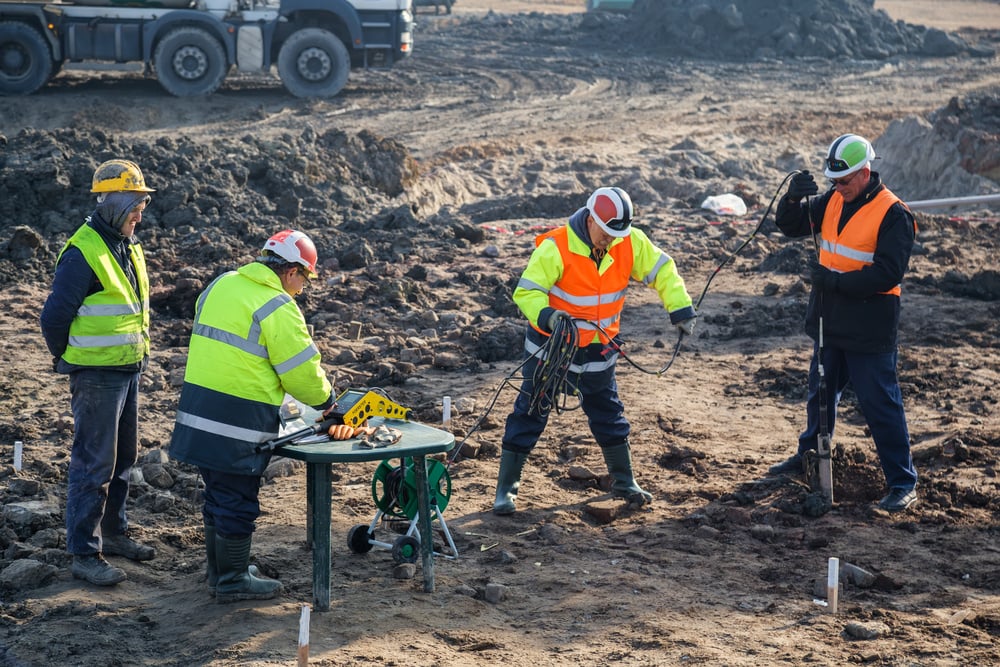Our Geotechnical Engineering For Construction Projects Diaries
Our Geotechnical Engineering For Construction Projects Diaries
Blog Article
Geotechnical Engineering For Construction Projects for Beginners
Table of ContentsThe 3-Minute Rule for Geotechnical Engineering For Construction Projects7 Simple Techniques For Geotechnical Engineering For Construction ProjectsThe Only Guide to Geotechnical Engineering For Construction ProjectsNot known Details About Geotechnical Engineering For Construction Projects The Only Guide for Geotechnical Engineering For Construction ProjectsUnknown Facts About Geotechnical Engineering For Construction ProjectsThe Single Strategy To Use For Geotechnical Engineering For Construction ProjectsWhat Does Geotechnical Engineering For Construction Projects Do?
Accompanying this boosted complexity comes geological and environmental aspects that impact the layout of the structure, which is arguably one of the most vital part of any type of development. Individuals need to trust that buildings, bridges, and highways will stand the examination of time. A Geotechnical designer advises on how a framework can best be sustained offering its unique conditions What's hidden below the surface area of the ground is likely the most important piece of info that a Geotechnical Engineer wants.These examples are after that examined by the lab to determine dirt composition (Geotechnical Engineering for Construction Projects). The failure of sand, silt, clay, and various other products existing in the soil, aids the designer determine what unique features the site has and what the effects of those may be. Obviously soil composition is just one examination that can be done on samples
The Only Guide to Geotechnical Engineering For Construction Projects
Based on these tests, there may be extra soil borings that are drilled, or the designer may have sufficient details from the preliminary tests to make a referral to the client on how finest to wage their task. Results are normally reported through borings logs which reveal the soil make-up and attributes at a variety of depths.
Geotechnical engineers are in charge of comprehending the properties of all-natural sources and using this understanding to create risk-free, affordable designs for building projects. It is an important part of any civil design job, as it is used to identify the viability of a website for construction and to guarantee the structure's security.
This consists of doing laboratory examinations on the examples and utilizing geophysical approaches such as seismic refraction and electric resistivity studies. This data is utilized to evaluate the site's suitability for construction and to figure out the kind of structure that ought to be used. Geotechnical engineering analyzes dirt problems, determines prospective risks, selects a suitable structure system for the recommended structure, and establishes the best foundation layout for a given task.
3 Simple Techniques For Geotechnical Engineering For Construction Projects
The framework may come to be unstable or collapse without appropriate dirt stabilisation, bring about pricey repair services and potential injury. The stablizing procedure entails making use of numerous techniques to boost the security of the soil, such as compaction, grouting, and the addition of enhancing products. Without soil stabilization, the dangers associated with building and construction jobs would be a lot higher, and the outcomes a lot less reputable.
It is a process used to enhance the residential properties of soils. Geotechnical engineers conduct site examinations to assess the soil's buildings and identify potential risks. They also create structures and other structures that need to be built on the website, taking into consideration the soil's attributes. They create and carry out dirt stablizing methods, such as including cement, lime, or other stabilizing representatives, to boost the dirt's stamina and security.
Excitement About Geotechnical Engineering For Construction Projects
Geotechnical designers are crucial click now in helping to ensure that soil stabilization is done properly to ensure that the framework is secure and safe and secure. Geotechnical engineering is likewise utilized to evaluate soil conditions and recognize possible dangers. This includes assessing prospective flooding, landslides, and other natural disasters that can impact the structure.
Geotechnical engineers use this understanding to carry out website examinations, soil, and rock screening, and to translate the outcomes to establish the suitable style criteria for a task. This information is used to make sure that the foundation, preserving walls, inclines, and various other frameworks improved or within the subsurface materials have enough security and resistance to external loads, such as earthquakes, wind, and water.
These structures require a deep understanding of the actions of the subsurface materials, in addition to the capability to take care of the influence of excavation and building on the surrounding setting. Geotechnical designers use their expertise to establish the suitable layout parameters for these structures, such as the shapes and size of the passage, the stamina of the sustaining rock, and the kind and quantity of support required.
Along with the design and construction of Website structures, geotechnical engineering likewise plays a critical function in the recovery and upkeep of existing frameworks. As structures age, they might experience destruction or other issues that impact their stability and performance. Geotechnical designers utilize their experience to evaluate the problem of these structures, recognize the root causes of the problems, and develop strategies to resolve them.
Everything about Geotechnical Engineering For Construction Projects
In this write-up, I will talk about the duty of geotechnical design and the types of problems geotechnical engineers resolve. Geotechnical engineers (geotechs) are associated with virtually every kind of civil design project. Besides, every structure is supported by dirt or rock unless it is floating, flying, or falling down.
Geotechs are normally most involved at the start of a task. Geotechnical Engineering for Construction Projects. A few of the jobs that a geotech may be in charge of are exploring subsurface problems, establishing called for laboratory testing of soil and rock, translating the subsurface exploration outcomes, and writing reports that record the website conditions and offer suggestions for structures, fill requirements, slope security, and so on
It is not unusual for geotechnical engineers to specialize in just one of the locations provided above and examine that subject their entire job. Geotechnical design is a vital element of any type of civil design task. Regardless of exactly how great a structure is constructed, it will certainly not be terrific for long if the foundation is insufficient.
Not known Facts About Geotechnical Engineering For Construction Projects

Usually, things that may not seem vital turn out visit here to be essential years later when issues develop. One last thing to remember: geotechnical engineering is married to geology. Despite how great your design experience is, if something crucial is missed in the geologic characterization at a site, your experience might not save you.
He delights in creeping about on any type of landslide he can discover and spending time fly fishing on the water. I hope you enjoyed this week's post by guest writer Jese Vance. I wish you'll join us.
Some Known Factual Statements About Geotechnical Engineering For Construction Projects

It is very important to develop the structure to withstand all-natural and manufactured tons. Loads can be upright or side. It is very important to know the dirt problem before creating the type and depth of foundation needed for the framework. In order to recognize the subsurface dirt condition, a geotechnical investigation is required.
The 10-Minute Rule for Geotechnical Engineering For Construction Projects
When the test results come, the Geotechnical Designer analyses the record, which outlines the dirt and rock properties groundwater problem and the associated dangers. The sort of foundation required to build the framework is after that figured out. Based on the suggestion of the Geotechnical Engineer, the architectural engineer after that develops the framework.
Report this page